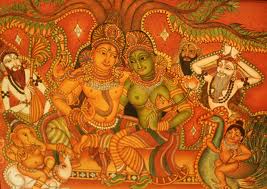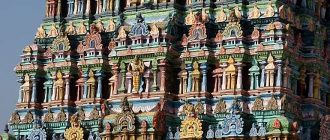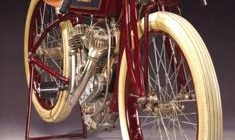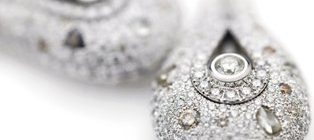Want to buy Indian mural paintings? Read on for facts and info on the distinctive Indian mural painting style…
India, specially its southern state of Kerala, is well known for the large frescoes and murals that adorn the temples in the South and primarily depict mythological and legendary religious figures and their epic battles and life stories. Ancient Indian religious artwork is as much known for the Indian mural paintings of Kerala as for the ancient Buddhist and Hindu stonework statues carved into caves and the sides of cliffs from thousands of years ago.
Evolution of Indian Religious Artwork
Some artwork found in India dates back as far as five thousand five hundred years. These were petroglyphs or stones that were etched or engraved with various implements. With the rise of Buddhism, stonework became an established art form and Buddhist statues were carved into walls in caves, the sides of cliffs or boulders, and later on the walls of buildings and temples. This art from was appropriated by the Hindus and Jains for their religious illustrations. The next advancement was the limestone based frescoes or murals which were painted on temple walls. The miniature style of painting was imported from Persia by the Mughals and there was some religious artwork in this form also. Oil paintings came to India in the nineteenth century and were quickly adapted to portraying mythological figures and legends.
Murals and Frescoes
Murals are basically artwork painted on walls, ceilings, or any large permanent surface; the fresco painted on the Sistine Chapel ceiling by Michelangelo is probably the most famous example of this art form. There are twenty thousand year old murals in the caves of Lascaux in the South of France and ancient murals also survive from the times of the Pharaohs and in the ruins of Pompeii.
The Fresco (Italian for fresh) technique of mural painting involves the rapid application of water-soluble pigments in a damp lime wash. The Buon Fresco technique involves applying water mixed paints on thin layers of fresh and wet lime mortar or plaster. This was a very durable method. Secco paintings are drawn on dry plaster and the paint is bound by egg tempera or other binding agents such as oil or glue. The Mezzo Fresco method favored by later painters such as Michelangelo uses nearly dry plaster to paint on.
The Kerala Murals and the Ajantha Cave Murals
The Kerala murals are recognized as some of the most exclusive and outstanding of all ancient murals. They date from the ninth century and are found on temple walls in the Southern Indian state. The world famous Ajantha caves in the Indian state of Maharashtra were a monastery from two thousand years ago. The twenty nine caves exhibit paintings on the walls, ceilings, and pillars. The famous Jataka tale series of murals is prominently displayed on only the walls and describes the Buddha’s life and teachings through his reincarnations though not in chronological order.
The technique applied in the Ajantha cave paintings is unique in all civilizations and was originally thought to be a type of fresco; a plaster of hay, clay, lime, and dung is applied to walls roughed up through chiseling and then the organic and stone color pigments are added to the wet plaster. Wet stucco which is a mixture of aggregate, binding agents, and water is then applied and allowed to harden.
The Kerala murals were applied in the Fresco-Secco style and the oldest are found in Thirunadhikkara Cave Temple now in Tamil Nadu state and in Tiruvanchikulam. Most famous are the Ramayana Murals in Matancherry Palace and those in the Shiva Temple in Ettumanoor.





